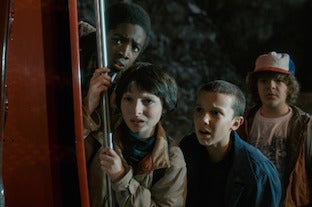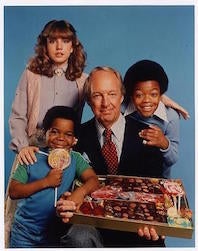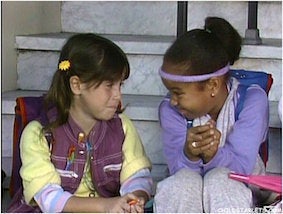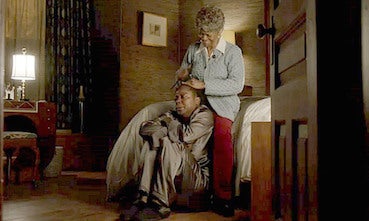Not one for science fiction, I figured I would try to get through one episode of Netflix series Stranger Things, if only to get in on the fervent conversation. I found myself watching all eight episodes over the course of two days, and immediately immersed myself in the analysis flooding the internet that week. Reviewers diligently laid out the classic elements of 80’s film & television that triggered such powerful nostalgia in so many viewers. Until this moment, I had no idea how much I’d missed watching latch-key-kid-centered, small-town-set narratives. Bullies are conquered, grown-ups are humorously exposed for the simpletons they are, teenagers struggle with virginity & peer-pressure, and on more than one instance, clever science saves the day! All agreed that the poignant chemistry between the kids’ characters serves ultimately as the heart of the show, and pivots it away from a gimmicky homage to the 80’s.
The story centers around Mike (the protagonist), his best friends Lucas (the cynic) and Dustin (the goof), a new-found mysterious companion, Eleven, and the search for their missing friend Will. The group’s friendship dynamic mirrors classic 80’s kid adventure crews, featured in such films as The Lost Boys, and Stand by Me.

What stood out to me immediately, was Lucas, one of a few black characters on the show. As the story progressed, I distractedly wondered who his family was, and what had brought them to that very white Indiana town. How do the other kids’ families feel about Lucas’ family? If Lucas had gone missing, would there have been a search party? (Although, no one seemed particularly bothered when Barb died, so that’s neither here nor there). Would the other moms have brought Lucas’ mom a lasagna while she grieved? Then, you have the schoolyard bullies, focused more on (presumably deceased) Will, referring to him as a ‘fag’, and on Dustin’s unfortunate dental issues than Lucas’ blackness as a target (although they do taunt him by calling him ‘Midnight’ at one point). As a testament to the show, it never felt as though Lucas didn’t belong in that world. Nevertheless, I wanted to see him actualized more as a person of color. Had it actually been 1983, my reaction would have been to feel grateful for his inclusion, period.
As an eighties kid, I watched a significant amount of television, and, naturally, wanted to see kids that looked like me represented in media. There was no shortage of minority representation on primetime television. You had your all-black shows, like, 227, A Different World and The Jeffersons, which meant to reflect a black experience. Other shows were more of a fish-bowl format ― about black characters navigating a predominantly white situation. Webster, Diff’rent Strokes, Benson and Gimme A Break were popular examples, with premises set in white households that revolved around either black adopted kids, or black domestic help.

Watching the all-black shows was like being in an affinity space, it at least felt as though the content was designed for and about black people. On the other hand, the shows in the Webster camp represented inclusion into the mainstream, which was clearly a tricky and often awkward thing to navigate. It’s disturbing to think that despite there being a demand for content that included people of color, these were the only integrated narratives the general public was comfortable with (although Benson did work his way up to lieutenant governor by the end of the series, so well done, them). Child-centric shows that got it right were The Cosby Show, Fat Albert and Sesame Street. Here was a rare opportunity to see black characters presented as something other than outliers that needed saving, or problems to be solved.
Stranger Things’ Lucas is reminiscent of the 80’s era loyal (often sassy) sidekick, whose role was to offset the lovable but straight and narrow protagonist (while providing a dose of street cred). I often found myself focused more on said sidekick, however meager his or her role. I was especially drawn to programming that featured brown kids in an integrated cast (as this mirrored my actual world), and these characters, although marginalized, were often less offensive than those that reinforced racist stereotypes. Notable roles were Tootie Ramsey from the Facts of Life, as the youngest at an all girls boarding house, Alfonso Spears on Silver Spoons as Ricky Schroder’s break-dancing best friend, Data the gadget wielding dork on The Goonies, and my personal favorite, Cherie Johnson, Punky Brewster’s level-headed best friend (mostly because I looked exactly like her).

It would be absurd to suggest that diverse casting require an accompanying plot with a social justice angle. Race, after all, need not be the focus on a show about, say, monsters in hidden dimensions. That said, one might question the authenticity of an imagined world which fails to notice the only brown person in it (unless, of course, its setting is post-racial, and by definition, alternate-reality). With this in mind, the question remains: must a writer adjust a character when a black actor is cast in a role? Moreover, are writers who choose not to do so succumbing to the short-sighted “I don’t see color” rhetoric, or are they simply being careless?
In 1968, Charles M. Schulz, who penned the famous Peanuts comic strip, received a letter from a concerned school teacher, who was white. She asked him if he’d consider adding a black character to the gang, and argued that it would help ‘shape the unconscious attitudes of our kids’ to see and read about black and white children integrating. Schulz wrote back that he felt it would be condescending to include a black character for the sake of it. I imagine he recognized the weight & responsibility attached to the task and decided he wasn’t prepared to provide such a character with an authentic voice. Eventually, Schulz did create Franklin ― Charlie Brown’s ultra laid back friend, who never said much. Franklin’s blackness was never acknowledged beyond physically in the cartoon, which seems appropriate for that era, when much of the public was openly shocked at his initial appearance. Nearly fifty years later, it’s somewhat reassuring to see that Franklin did play a more prominent role in 2015’s Peanuts Movie.

I can appreciate that on Stranger Things, the Duffer brothers could have been, by avoiding allusions to race, keeping the ‘80s feel all the way real. In spite of this, writing authentic characters of color without necessarily ‘making it about race’ continues to be a real struggle in film and television. It is rare to see dialogue and action that subtly reflects ordinary moments and situations plausibly experienced by an actual person of color. An obvious solution is to hire more writers of color on projects. Scandal and How To Get Away With Murder stand out as a holy grail show among black women, in large part, because of Shonda Rhimes’ inclusion of detail (not necessarily an overarching theme) that reflects a distinctly black reality. A flashback featuring Viola Davis’ character sitting between her mother’s legs as she braids her hair is moving for a black audience as a familiar shared experience that is rarely represented in mainstream media. Sidenote: Rhimes doesn’t always get it right ― witness Black Twitter explode when Olivia Pope steps out of the shower with soaking wet hair only to appear inexplicably in the next scene rocking a salon blowout.

If authenticity is the goal, writers must be involved who have an understanding of how a non-white experience looks, sounds and feels. Despite this, diverse writing teams continue to be a rarity. In the New Yorker feature In Living Color, Emily Nussbaum chronicles Kenya Barris’ (creator of ABC’s Blackish) experiences as a black writer and show developer in Hollywood. Barris describes the challenge faced as a “diversity hire” among predominantly white writing staffs on white shows, as well as witnessing their disconnectedness when writing black characters. This would explain why so many characters of color are either written as though they were white, or as blatant black stereotypes. Take for example, a black, Kanye-esque character on the FX show You’re The Worst named, laughably, “Shitstain.” The show’s writers attempt to depict a complex street-yet-smart skaterboy rapper, but instead, we end up with an ignorant-sounding, unlikeable and offensive caricature.

Meanwhile, majority non-white cast shows understand the importance of using writers of color, as Slate writer Aisha Harris points out. Today, those shows are among network television’s most successful, as well as created or executively produced by people of color-among them are the aforementioned Barris, Rhimes, and Empire’s Lee Daniels. Non-white shows, headed by non-white execs, it would seem, are the only place writers of color have a seat at the table.
Since the 80s, we have made progress: successful Black, Hispanic and Asian shows are being created, written, and produced by people of color now, resulting in authentic-feeling characters that are representative of the people they depict. Also, Hollywood has developed more sensibility in recognizing and avoiding overtly racist premises and stereotypes. Sadly, however, most white-majority cast shows continue to feature, if at all, token brown characters that are either written poorly, or underdeveloped. The non-white minor character may seem doomed to remain forever marginalized. Fortunately however, it’s 2016 and we no longer have just four or five channels to choose from. Television today is saturated with hundreds of networks turning out countless shows each season, and some do get it right. By paying attention to lazy writing and non-inclusive casting, it really is possible as viewers to hone in on quality shows that acknowledge their non-white audience by including believable characters of color.
